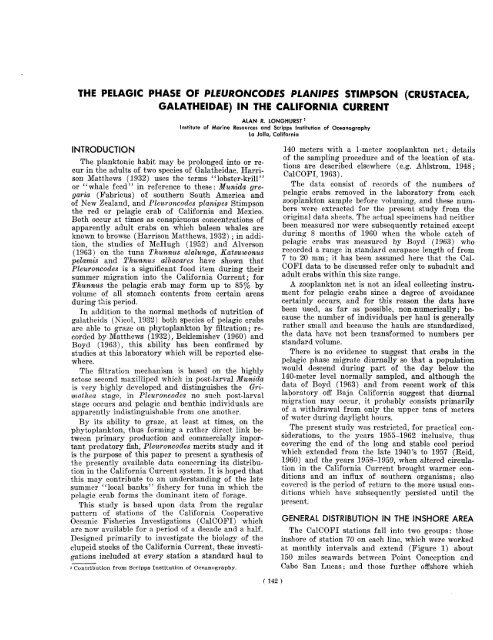CalCOFI Reports, Vol. 11, 1967 - California Cooperative Oceanic ...
CalCOFI Reports, Vol. 11, 1967 - California Cooperative Oceanic ...
CalCOFI Reports, Vol. 11, 1967 - California Cooperative Oceanic ...
You also want an ePaper? Increase the reach of your titles
YUMPU automatically turns print PDFs into web optimized ePapers that Google loves.
THE PELAGIC PHASE OF PLEURONCODES PLANIPES STIMPSON (CRUSTACEA,GALATHEIDAE) IN THE CALIFORNIA CURRENTALAN R. LONGHURST’Institute of Marine Resources and Scripps Institution of OceanographyLa Jolla, <strong>California</strong>INTRODUCTIONThe planktonic habit may be prolonged into or recurin the adults of two species of Galatheidae. HarrisonMatthews (1932) uses the terms “lobster-krill”or “whale feed” in reference to these: Munida gregaria(Fabricus) of southern South America andof New Zealand, and Pleuroncodes planipes Stimpsonthe red or pelagic crab of <strong>California</strong> and Mexico.Both occur at times as conspicuous concentrations ofapparently adult crabs on which baleen whales areknown to browse (Harrison Matthews, 1932) ; in addition,the studies of McHugh (1952) and Alverson(1963) on the tuna Thunnus alalunga, Katsuwonuspelamis and Thunnus albacares have shown thatPleuroncodes is a significant food item during theirsummer migration into the <strong>California</strong> Current; forThunnus the pelagic crab may form up to 85% byvolume of all stomach contents from certain areasduring this period.In addition to the normal methods of nutrition ofgalatheids (Nicol, 1932) both species of pelagic crabsare able to graze on phytoplankton by filtration ; recordedby Matthews (1932), Beklemishev (1960) andBoyd (1963), this ability has been confirmed bystudies at this laboratory which will be reported elsewhere.The filtration mechanism is based on the highlysetose second maxilliped which in post-larval Munidais very highly developed and distinguishes the Grimotlzeastage, in Pleuroncodes no such post-larvalstage occurs and pelagic and benthic individuals areapparently indistinguishable from one another.By its ability to graze, at least at times, on thephytoplankton, thus forming a rather direct link betweenprimary production and commercially importantpredatory fish, Pleuroncodes merits study and itis the purpose of this paper to present a synthesis ofthe presently available data concerning its distributionin the <strong>California</strong> Current system. It is hoped thatthis may contribute to an understanding of the latesummer L‘local banks” fishery for tuna in which thepelagic crab forms the dominant item of forage.This study is based upon data from the regularpattern of stations of the <strong>California</strong> <strong>Cooperative</strong><strong>Oceanic</strong> Fisheries Investigations ( <strong>CalCOFI</strong>) whichare now available for a period of a decade and a half.Designed primarily to investigate the biology of theclupeid stocks of the <strong>California</strong> Current, these investigationsincluded at every station a standard haul to1 Contribution from Scripps Institution of Oceanography.140 meters with a l-meter zooplankton net; detailsof the sampling procedure and of the location of stationsare described elsewhere (e.g. Ahlstrom, 1948 ;<strong>CalCOFI</strong>, 1963).The data consist of records of the numbers ofpelagic crabs removed in the laboratory from eachzooplankton sample before voluming, and these numberswere extracted for the present study from theoriginal data sheets. The actual specimens had neitherbeen measured nor were subsequently retained exceptduring 8 months of 1960 when the whole catch ofpelagic crabs was measured by Boyd (1963) whorecorded a range in standard carapace length of from7 to 20 mm; it has been assumed here that the Cal-COFI data to be discussed refer only to subadult andadult crabs within this size range.A zooplankton net is not an ideal collecting instrumentfor pelagic crabs since a degree of avoidancecertainly occurs, and for this reason the data havebeen used, as far as possible, non-numerically ; becausethe number of individuals per haul is generallyrather small and because the hauls are standardized,the data have not been transformed to numbers perstandard volume.There is no evidence to suggest that crabs in thepelagic phase migrate diurnally so that a populationwould descend during part of the day below the140-meter level normally sampled, and although thedata of Boyd (1963) and from recent work of thislaboratory off Baja <strong>California</strong> suggest that diurnalmigration may occur, it probably consists primarilyof a withdrawal from only the upper tens of metersof water during daylight hours.The present study was restricted, for practical considerations,to the years 1955-1962 inclusive, thuscovering the end of the long and stable cool periodwhich extended from the late 1940’s to 1957 (Reid,1960) and the years 1988-1959, when altered circulationin the <strong>California</strong> Current brought warmer conditionsand an influx of southern organisms; alsocovered is the period of return to the more usual conditionswhich have subsequently persisted until thepresent.GENERAL DISTRIBUTION IN THE INSHORE AREAThe <strong>CalCOFI</strong> stations fall into two groups: thoseinshore of station 70 on each line, which were workedat monthly intervals and extend (Figure 1) about150 miles seawards between Point Conception andCab0 San Lucas; and those further offshore which( 142 )















